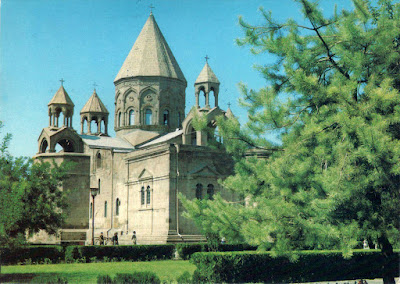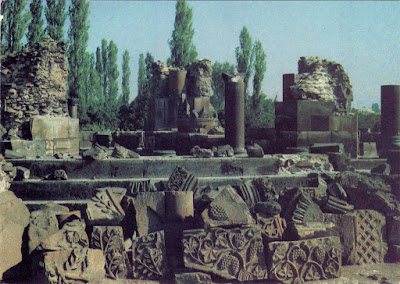 |
| 1805 Etchmiadzin Cathedral (1) |
According to UNESCO, "the cathedral and churches of Echmiatzin and the archaeological remains at Zvartnots graphically illustrate the evolution and development of the Armenian central-domed cross-hall type of church, which exerted a profound influence on architectural and artistic development in the region." Built between 301 and 303 in Vagharshapat (Etchmiadzin), the capital and religious centre of Armenia at that time, by Armenia's patron saint Gregory the Illuminator, following the adoption of Christianity as a state religion by King Tiridates III, the Echmiatzin Cathedral was the first cathedral (but not the first church) erected in ancient Armenia, and is considered the oldest cathedral in the world. It replaced a preexisting temple, symbolizing the conversion from paganism to Christianity.
 |
| 1806 Etchmiadzin Cathedral (2) |
It was originally a vaulted basilica, and it was given its present cruciform plan during restoration work in 480. In 618 the wooden cupola was replaced with an identical one in stone which survives almost unchanged. Its mass is supported on four massive independent pillars connected by slender arcades within the exterior walls; those on the northern side belonged to the 4th and 5th centuries. A three-tier belfry was built in front of the western entrance in the 17th century. The six-column rotundas on four-pillar bases, built at the beginning of the 18th century over the northern, eastern and southern apses, give the cathedral a five-domed outline.
 |
| 1797 Zvartnots Cathedral |
Now in ruins, Zvartnots Cathedral (meaning "celestial angels") is a centrally planned aisled tetraconch type Armenian cathedral built by the order of Catholicos Nerses the Builder between 643 and 652. Dedicated to St. Gregory, it was located the place where a meeting between King Tiridates III and Gregory the Illuminator was supposed to have taken place. Following the Arab occupation of Dvin and the intensifying wars between the Byzantine and Arab armies on the former's eastern borders, Nerses transferred the patriarchal palace of the Catholicos from Dvin to Zvartnots.
Zvartnots remained standing until the end of the 10th century, but historical sources are silent as to the cause of its collapse. The ruins remained buried until its remains were uncovered at the start of the 20th century. The interior of the mosaic-decorated church had the shape of a Greek cross or tetraconch, with an aisle encircling this area, while the exterior was a 32-sided polygon which appeared circular from a distance. Some sources claim that the Zvartnots cathedral is depicted upon Mount Ararat in a relief in Sainte-Chapelle in Paris.
About the stamps
The postcard being sent from Nagorno-Karabakh Republic, the stamps were released by this entity.
On the postcard 1797
The stamp is part of the series of two issued in 2013 and depicting Artsakh Churches.
On the postcard 1805
The first stamp is part of the series issued with the occasion of The 5th Anniversary of Independence of the republic, about which I wrote here. The second stamp is part of a series of two, issued in 1998 to celebrate The 5th Anniversary of Liberation of Shushi.
On the postcard 1806
The first stamp is part of the series issued with the occasion of The 5th Anniversary of Independence of the republic, about which I wrote here.The last stamp, depicting the monastery of Dadivank, is part of the Buildings set, issued on September 2, 1996.
References
Zvartnots Cathedral - Wikipedia
Etchmiadzin Cathedral - Wikipedia
Cathedral and Churches of Etchmiadzin and the Archaeological Site of Zvartnots - UNESCO
Sender 1797, 1805, 1806: Sergey Kalantaryan
1797, 1805, 1806: Sent from Stepanakert (Artsakh / Nagorno-Karabakh), on 29.05.2015
Photo: V. Panova



No comments:
Post a Comment